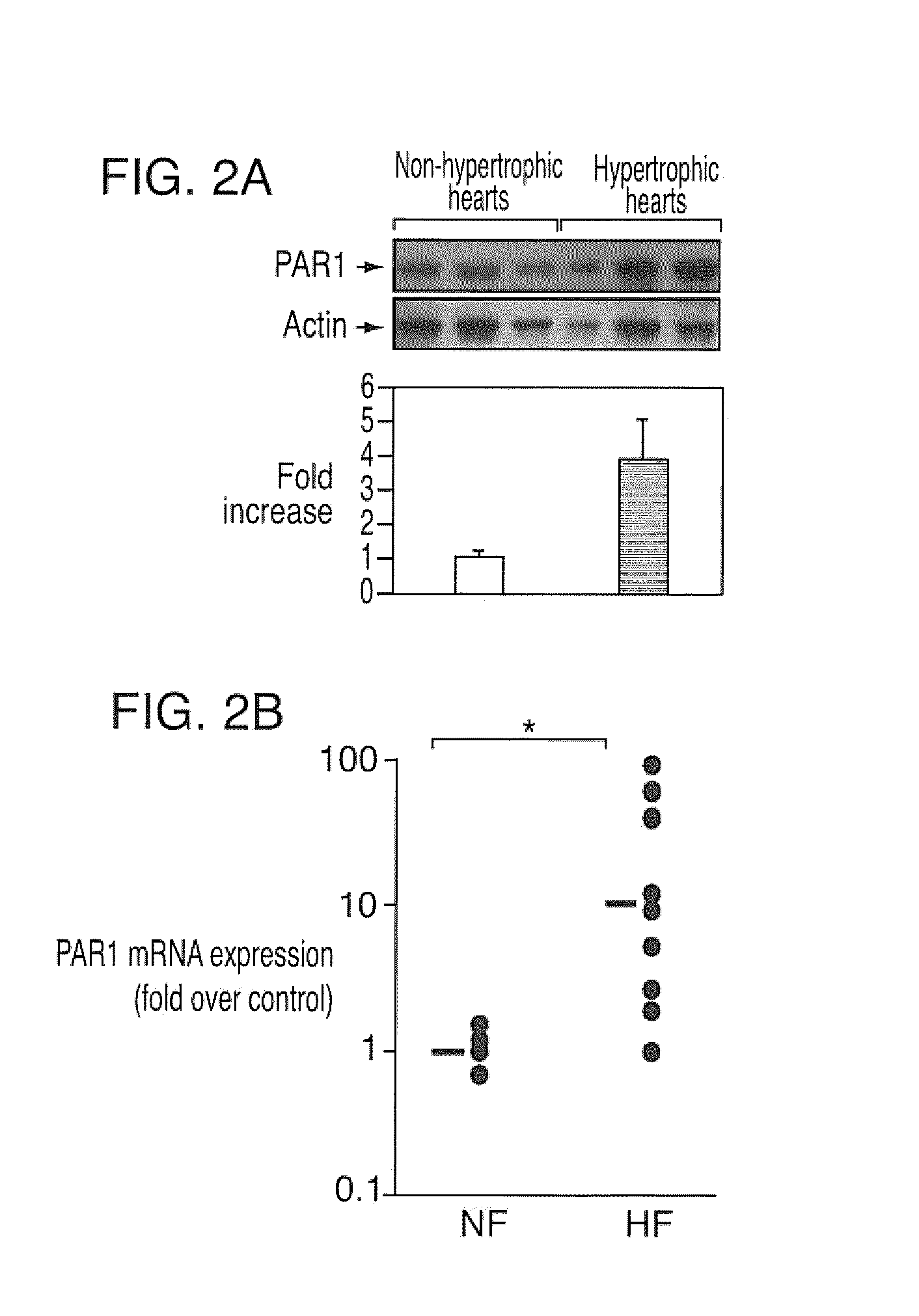Methods and compositions for treating cardiac dysfunctions
a technology for cardiac dysfunction and composition, applied in the field of cardiac dysfunction, can solve the problems of cardiac dysfunction, ischemia and infarction, progressive congestive heart failure, etc., and achieve the effect of treating or preventing cardiac dysfunction
- Summary
- Abstract
- Description
- Claims
- Application Information
AI Technical Summary
Benefits of technology
Problems solved by technology
Method used
Image
Examples
example 1
Materials and Methods
[0208]Mice. PAR1+ / − mice were backcrossed 11 generations onto a C57BI / 6J background and bred to generate PAR1+ / + and PAR1− / − littermate mice. αMHC-Cre mice were a generous gift from Dr. E. Abel (University of Utah School of Medicine). This study was performed in accordance with the guidelines of the Animal Care and Use Committees of The Scripps Research Institute, La Jolla, Calif., the University of Washington, Seattle, Wash., and the University of Rochester, Rochester, N.Y. and complies with NIH guidelines.
[0209]Generation of αMHC-PAR1 mice. A 1.3 kbp DNA fragment containing the coding sequence of mouse PAR1 was cloned into a vector containing the cardiomyocyte-specific αMHC promoter (kindly provided by Dr. F. Naya). This promoter is a promoter that drives gene expression in cardiomyocytes. The background of these mice is C57BL / 6. Next, an 8.5 kbp Not1 fragment, which contained the αMHC promoter, the coding sequence for mouse PAR1 and the human growth hormone p...
example 2
PAR1 Deficiency Does Not Affect Infarct Size After I / R Injury
[0220]Based on our previous studies showing that inhibition of either TF or thrombin reduced infarct size (Erlich et al., Am. J. Pathol. 157:1849-1862 (2000)), we hypothesized that PAR1 deficiency would reduce infarct size. We used a mouse model of short-term cardiac I / R injury that consists of 30 minutes of ischemia and 2 hours of reperfusion. Surprisingly, we found no significant difference in the infarct size between PAR1− / − mice and WT littermates (FIG. 1A). In contrast, inhibition of thrombin with hirudin decreased infarct size (FIG. 1A). Neither hirudin treatment nor PAR1 deficiency affected the size of the area at-risk. Furthermore, PAR1 deficiency did not affect the induction of various inflammatory mediators (IL-1β, IL-6, MIP-2 and MCP-1) in the injured hearts (data not shown). These results indicate that PAR1 does not contribute to infarct size or inflammation after I / R injury.
example 3
PAR1− / − Mice Have Reduced Cardiac Remodeling After I / R Injury
[0221]The majority of cardiac remodeling after myocardial infarction is due to hypertrophy of cardiomyocytes and proliferation of cardiac fibroblasts. Despite the fact that PAR1 did not contribute to infarct size, we hypothesized that PAR1 signaling plays a role in cardiac remodeling after myocardial infarction by inducing hypertrophy of cardiomyocytes and cell proliferation of cardiac fibroblasts. We used a long-term mouse model of cardiac I / R injury consisting of 45 minutes of ischemia and 2 weeks of reperfusion to induce cardiac remodeling. Echocardiography showed that after cardiac I / R injury the hearts of WT mice exhibited dilation of the LV, significant impairment of LV function and thinning of the posterior LV wall at systole (FIG. 1B). In contrast, PAR1− / − mice exhibited strikingly less dilation of the LV and reduced impairment of LV function (FIG. 1B). Similar results were observed in an independent experiment wit...
PUM
| Property | Measurement | Unit |
|---|---|---|
| concentration | aaaaa | aaaaa |
| concentration | aaaaa | aaaaa |
| tidal volume | aaaaa | aaaaa |
Abstract
Description
Claims
Application Information
 Login to View More
Login to View More - R&D
- Intellectual Property
- Life Sciences
- Materials
- Tech Scout
- Unparalleled Data Quality
- Higher Quality Content
- 60% Fewer Hallucinations
Browse by: Latest US Patents, China's latest patents, Technical Efficacy Thesaurus, Application Domain, Technology Topic, Popular Technical Reports.
© 2025 PatSnap. All rights reserved.Legal|Privacy policy|Modern Slavery Act Transparency Statement|Sitemap|About US| Contact US: help@patsnap.com



